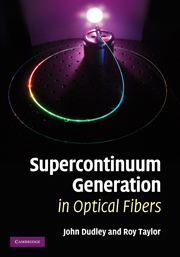Book contents
- Frontmatter
- Contents
- List of contributors
- Preface
- 1 Introduction and history
- 2 Supercontinuum generation in microstructure fibers – a historical note
- 3 Nonlinear fibre optics overview
- 4 Fibre supercontinuum generation overview
- 5 Silica fibres for supercontinuum generation
- 6 Supercontinuum generation and nonlinearity in soft glass fibres
- 7 Increasing the blue-shift of a picosecond pumped supercontinuum
- 8 Continuous wave supercontinuum generation
- 9 Theory of supercontinuum and interaction of solitons with dispersive waves
- 10 Interaction of four-wave mixing and stimulated Raman scattering in optical fibers
- 11 Nonlinear optics in emerging waveguides: revised fundamentals and implications
- 12 Supercontinuum generation in dispersion-varying fibers
- 13 Supercontinuum generation in chalcogenide glass waveguides
- 14 Supercontinuum generation for carrier-envelope phase stabilization of mode-locked lasers
- 15 Biophotonics applications of supercontinuum generation
- 16 Fiber sources of tailored supercontinuum in nonlinear microspectroscopy and imaging
- Index
5 - Silica fibres for supercontinuum generation
Published online by Cambridge University Press: 06 July 2010
- Frontmatter
- Contents
- List of contributors
- Preface
- 1 Introduction and history
- 2 Supercontinuum generation in microstructure fibers – a historical note
- 3 Nonlinear fibre optics overview
- 4 Fibre supercontinuum generation overview
- 5 Silica fibres for supercontinuum generation
- 6 Supercontinuum generation and nonlinearity in soft glass fibres
- 7 Increasing the blue-shift of a picosecond pumped supercontinuum
- 8 Continuous wave supercontinuum generation
- 9 Theory of supercontinuum and interaction of solitons with dispersive waves
- 10 Interaction of four-wave mixing and stimulated Raman scattering in optical fibers
- 11 Nonlinear optics in emerging waveguides: revised fundamentals and implications
- 12 Supercontinuum generation in dispersion-varying fibers
- 13 Supercontinuum generation in chalcogenide glass waveguides
- 14 Supercontinuum generation for carrier-envelope phase stabilization of mode-locked lasers
- 15 Biophotonics applications of supercontinuum generation
- 16 Fiber sources of tailored supercontinuum in nonlinear microspectroscopy and imaging
- Index
Summary
Introduction
The generic single-mode optical fibre is a fibre drawn from fused silica. Silica fibres are available at very low cost, being produced by sophisticated processes in massive quantity for the global telecommunications network. They are very transparent, and much optical equipment is designed around their transparency windows, making research at these wavelengths particularly convenient. Devices or effects using silica fibres are therefore compatible with a wide range of existing optical fibre technologies, and so easy to incorporate into existing systems should the need or opportunity arise. Silica fibres are available in a wide range of different forms, especially with the development and commercial availability of silica photonic crystal fibres (PCF) and microstructured fibres.
Many of the above arguments rely for their worth on the already widespread deployment of silica optical fibres. However, there are also fundamental reasons to work with silica fibres, many of them the same reasons that they are already so popular. Silica – glassy SiO2 – can be synthesised with remarkably high levels of purity at very low cost: silicon is an abundant and easily-obtained element in the earth's crust, while the chemical processes used to synthesise silica are efficient and simple. Of course, the fact that these processes have been scaled up to produce large volumes of material further reduces the cost of production. The transparency window of silica is broad, spanning both visible and near-infra-red wavelengths. Practically, silica optical fibres are usually used in the spectral range 300–2500 nm.
- Type
- Chapter
- Information
- Supercontinuum Generation in Optical Fibers , pp. 62 - 81Publisher: Cambridge University PressPrint publication year: 2010
- 2
- Cited by

